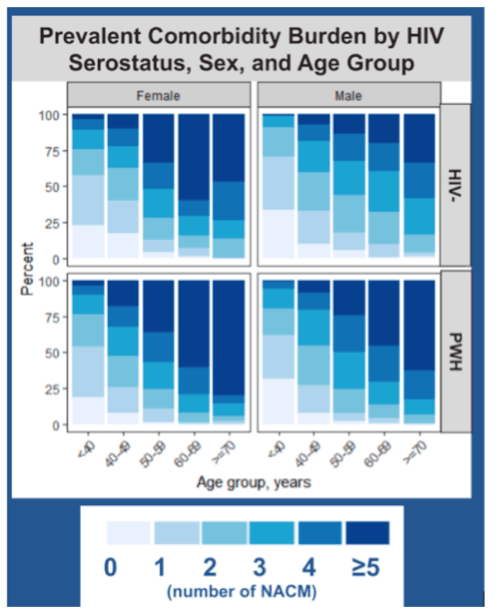 |
 |
 |
| |
Women & HIV at CROI
|
| |
| |
CROI: HIV DIFFERENTIALLY IMPACTS AGE-RELATED COMORBIDITY BURDEN AMONG US WOMEN AND MEN - (03/06/21) When HIV+ men & women reach 70 years old the rates of having 5 or more comorbidities jump a lot higher . For HIV+ women these rates jump a lot higher after 60 years of age. These big jumps occur for HIV+ men too after 60 but the jumps are bigger for HIV+ women. Conclusion: The prevalence and burden of NACM was high in the MWCCS among men and women with or at-risk for HIV, particularly for hypertension, psychiatric illness, dyslipidemia, liver, and bone disease. NACM burden was higher in women vs men, particularly among PWH, and the distribution of specific NACM prevalence differed by sex. Given HIV is associated with differential effects on age-related comorbidities by sex, HIV serostatus- and sex-specific strategies for NACM screening and prevention are needed.

CROI: Female Sex Modifies Link Between Inflammation and Non-AIDS Vascular Events - (03/08/21)
CROI: SEX MODIFIES THE ASSOCIATION BETWEEN INFLAMMATION AND VASCULAR EVENTS IN TREATED HIV - (03/08/21) Conclusion: Discrete pathways of inflammation independently predict CVD and VTE events in treated HIV, and many of these pathways are modified by sex. As inflammation predicts CVD events more strongly in women than in men, representation of women in clinical studies of immune-based interventions in treated HIV infection is critical.
HIV+ Women Have Higher Burden of Comorbidities vs HIV- Women / Accelerated-Earlier by 10 Years - (03/02/21) Non-AIDS comorbidities are leading causes of death in people living with human immunodeficiency virus (HIV), particularly among individuals on chronic antiretroviral therapy (ART) [1]. Increasing Evidence that women living with HIV have a high burden of non-AIDS comorbidities....."In conclusion, WLWH living in the United States experienced a high overall burden of age-associated NACMs compared with HIV-seronegative counterparts”. Human immunodeficiency virus infection accelerates the development of age-related comorbidities, with research showing that the presence of 2 or more conditions, such as diabetes mellitus, hypertension, cardiovascular disease, kidney disease, and bone fractures, may occur about a decade earlier in persons living with HIV compared with individuals without HIV….data should motivate various agencies and organizations to dedicate additional funding to allow researchers to continue to unravel these mysteries with the aim of helping to alleviate suffering for those afflicted by a chronic disease without a cure
CROI: T-CELL IMMUNE DYSREGULATION AND MORTALITY IN WOMEN WITH HIV - (03/15/21) Multiparameter flow cytometry was applied to peripheral blood mononuclear cells from 612 women with HIV in the Women’s Interagency HIV Study (WIHS).. Higher activation, senescence, and exhaustion of CD4+ T-cells, activation of CD8+ T-cells, and lower co-stimulation of CD4+ T-cells, were significantly associated with natural cause mortality, adjusting for age, demographic, and behavioral characteristics (Figure 1)
CROI: SEX DIFFERENCES IN DIABETES PREVELANCE AMONG PERSONS WITH HIV IN THE UNITED STATES...40% of HIV+ Women >65 have diabetes. - (03/19/21)
CROI: IMPACT OF REPRODUCTIVE AGING ON HIV PERSISTENCE IN CISGENDER MEN AND WOMEN WITH HIV - (03/19/21)
Burden of Hypertension, Diabetes, Cardiovascular Disease, and Lung Disease Among Women Living With Human Immunodeficiency Virus (HIV) in the United States - (03/18/21)
CROI: BEYOND PAIN: PRESCRIPTION OPIOID USE IN THE WOMEN'S INTERAGENCY HIV STUDY - (03/14/21) ..use has doubled, WLWH had 56% increased chronic prescription opioid use....increased mortality...sexual minority women had 70% increased use Why do HIV+ women’s issues get so little broad discussion & attention. Despite federally mandated changes in opioid prescribing guidelines, prescription opioid use in the WIHS significantly increased from 2000-2019. Findings underscore the need for non-opioid and non- pharmacologic interventions for chronic pain in sexual minorities and WLWH. Concurrent use of benzodiazepines and non-prescription drugs should also be addressed and treated to reduce risk of mortality.
|
| |
|
 |
 |
|
|